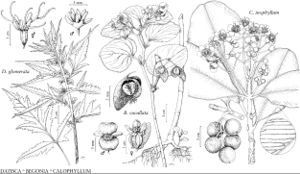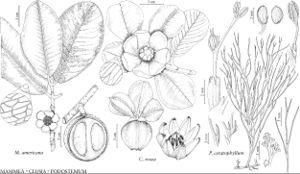Trees [shrubs], polygamous or dioecious, glabrous or hairy, hairs unicellular or multicellular, with glandular canals containing latex. Leaves opposite [alternate], decussate, simple, petiolate; blade: margins entire, surfaces with ± spherical glands containing secretions other than hypericin and pseudohypericin. Inflorescences axillary [terminal], pedicellate. Flowers bisexual or unisexual, homostylous; sepals persistent or deciduous, 2–4[–16], distinct or connate, inner pair often petaloid; petals deciduous, [0–]4–6[–8], decussate [contorted]; filaments basally connate [distinct], slender; anthers eglandular [glandular], dehiscing longitudinally; ovary superior, 1–8-locular; placentation basal; style 1; stigma ± expanded to peltate. Fruits baccate or drupaceous [capsular]. Seeds not arillate; embryo length 1/3+ times seed, cotyledons large.
Distribution
Introduced; Fla., Mexico, West Indies, Central America, South America, Asia, Africa, Indian Ocean Islands (Madagascar), Pacific Islands, Australia, pantropical.
Discussion
Genera 14, species ca. 490 (2 genera, 2 species in the flora).
Selected References
Lower Taxa
Illustrations
Key
| 1 | Styles slender, lengths ca. 4 times ovary; sepals 4, distinct; leaves without tertiary venation visible between lateral veins. | Calophyllum |
| 1 | Styles thick, very short; sepals 2 or 3, completely connate in bud; leaves with tertiary venation prominent between lateral veins. | Mammea |

